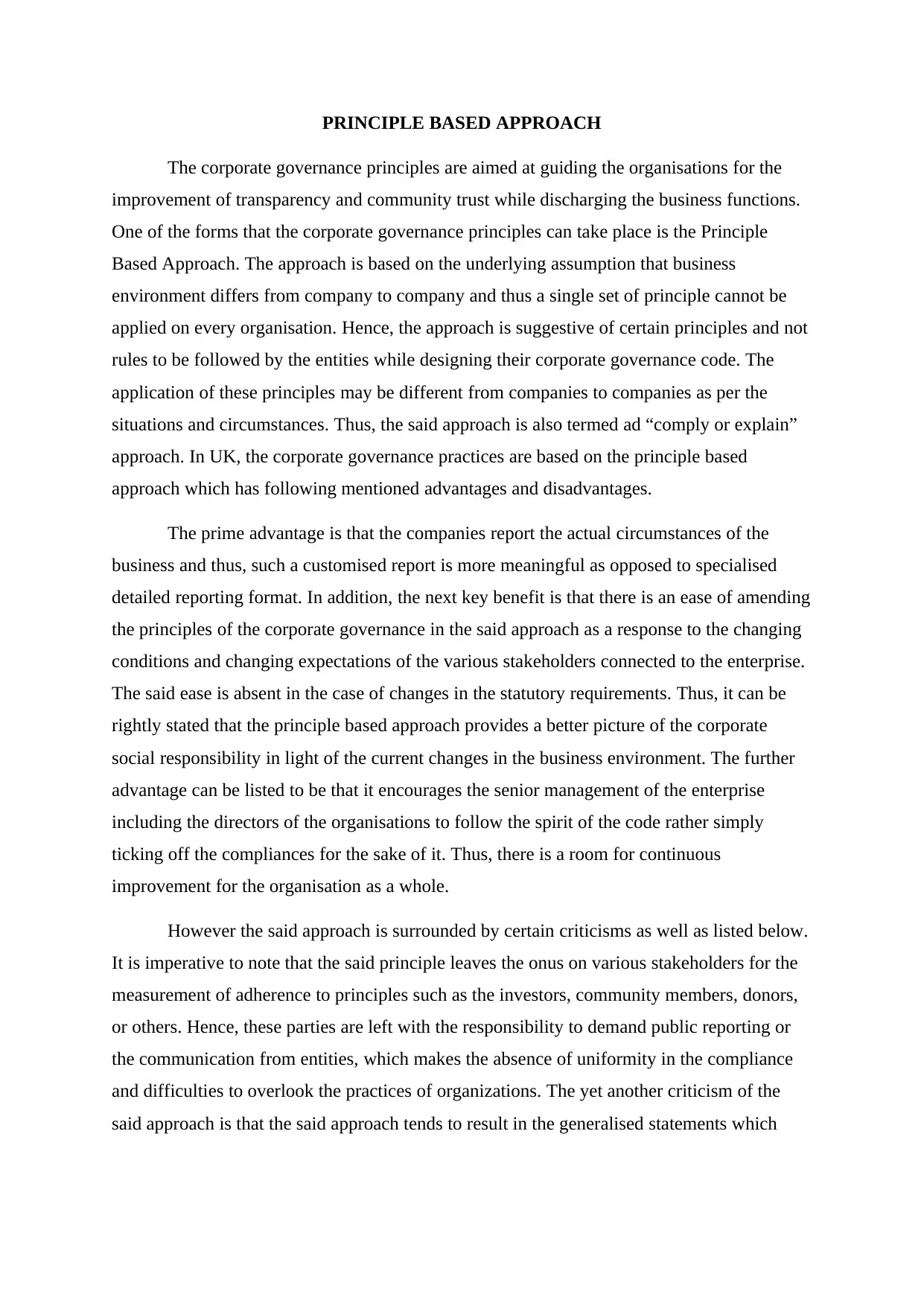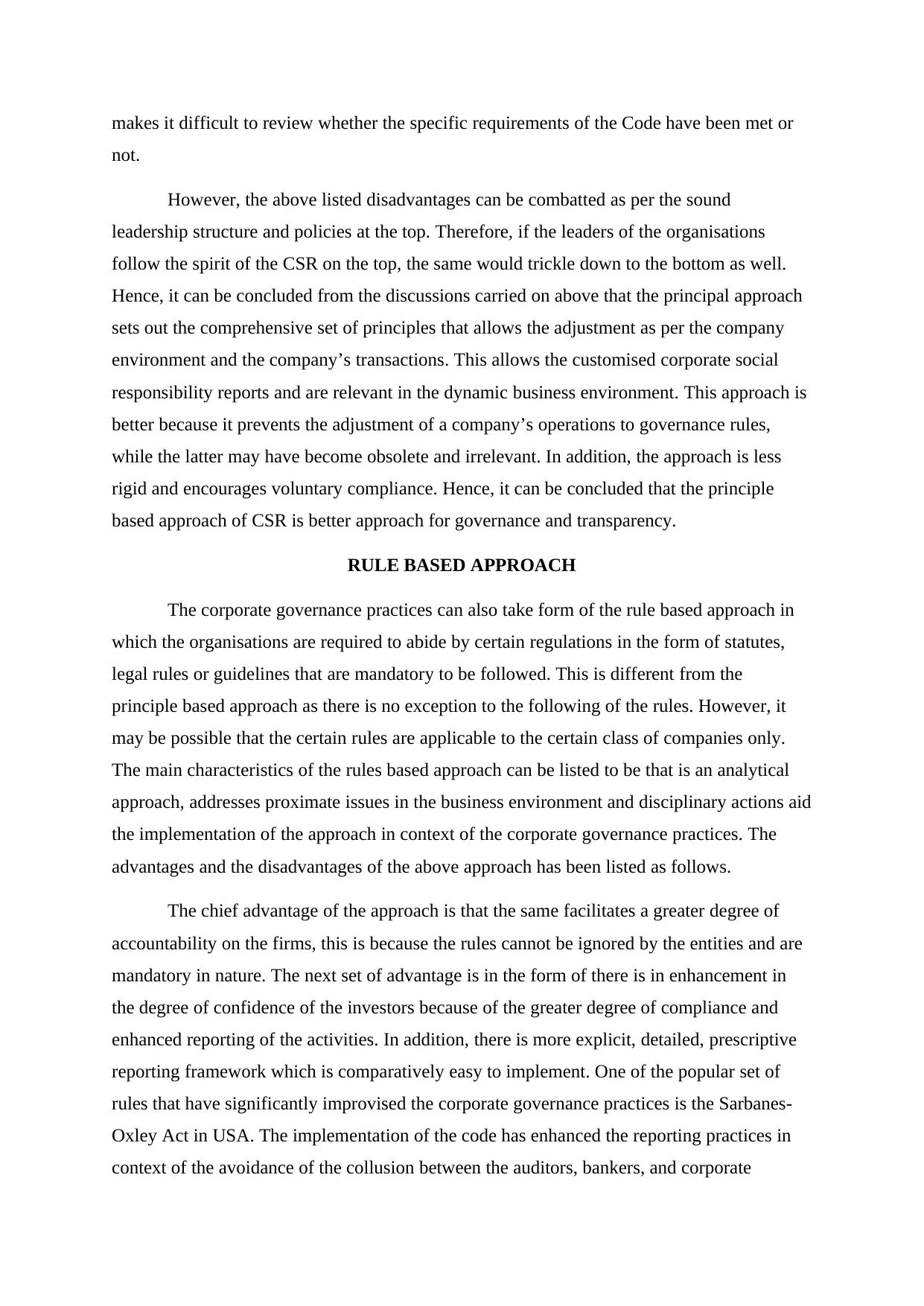Editorial Essay: Evaluating Corporate Governance Approaches (LB 5231)
VerifiedAdded on 2022/12/27
|5
|1310
|46
Essay
AI Summary
This essay analyzes two contrasting approaches to corporate governance: the principle-based approach, favored by the Financial Review, and the rule-based approach, championed by the Global Times. The principle-based approach emphasizes flexibility, allowing companies to tailor their corporate social responsibility (CSR) practices to their specific circumstances, promoting transparency and community trust through a "comply or explain" model. It highlights the advantages of adaptability and encourages senior management to embrace the spirit of the code. Conversely, the rule-based approach, exemplified by the Sarbanes-Oxley Act, mandates adherence to specific regulations, fostering greater accountability and investor confidence through explicit reporting frameworks and disciplinary actions. The essay explores the advantages and disadvantages of each approach, concluding that the principle-based approach is better because it allows for customized CSR reports, promotes voluntary compliance, and prevents companies from adhering to obsolete rules. The rule-based approach is better as strict rules are required to be followed to ensure compliance and accountability. The essay draws from a selection of academic sources to support its arguments.

ETHICS AND CORPORATE SOCIAL RESPONSIBILITY
Paraphrase This Document
Need a fresh take? Get an instant paraphrase of this document with our AI Paraphraser

PRINCIPLE BASED APPROACH
The corporate governance principles are aimed at guiding the organisations for the
improvement of transparency and community trust while discharging the business functions.
One of the forms that the corporate governance principles can take place is the Principle
Based Approach. The approach is based on the underlying assumption that business
environment differs from company to company and thus a single set of principle cannot be
applied on every organisation. Hence, the approach is suggestive of certain principles and not
rules to be followed by the entities while designing their corporate governance code. The
application of these principles may be different from companies to companies as per the
situations and circumstances. Thus, the said approach is also termed ad “comply or explain”
approach. In UK, the corporate governance practices are based on the principle based
approach which has following mentioned advantages and disadvantages.
The prime advantage is that the companies report the actual circumstances of the
business and thus, such a customised report is more meaningful as opposed to specialised
detailed reporting format. In addition, the next key benefit is that there is an ease of amending
the principles of the corporate governance in the said approach as a response to the changing
conditions and changing expectations of the various stakeholders connected to the enterprise.
The said ease is absent in the case of changes in the statutory requirements. Thus, it can be
rightly stated that the principle based approach provides a better picture of the corporate
social responsibility in light of the current changes in the business environment. The further
advantage can be listed to be that it encourages the senior management of the enterprise
including the directors of the organisations to follow the spirit of the code rather simply
ticking off the compliances for the sake of it. Thus, there is a room for continuous
improvement for the organisation as a whole.
However the said approach is surrounded by certain criticisms as well as listed below.
It is imperative to note that the said principle leaves the onus on various stakeholders for the
measurement of adherence to principles such as the investors, community members, donors,
or others. Hence, these parties are left with the responsibility to demand public reporting or
the communication from entities, which makes the absence of uniformity in the compliance
and difficulties to overlook the practices of organizations. The yet another criticism of the
said approach is that the said approach tends to result in the generalised statements which
The corporate governance principles are aimed at guiding the organisations for the
improvement of transparency and community trust while discharging the business functions.
One of the forms that the corporate governance principles can take place is the Principle
Based Approach. The approach is based on the underlying assumption that business
environment differs from company to company and thus a single set of principle cannot be
applied on every organisation. Hence, the approach is suggestive of certain principles and not
rules to be followed by the entities while designing their corporate governance code. The
application of these principles may be different from companies to companies as per the
situations and circumstances. Thus, the said approach is also termed ad “comply or explain”
approach. In UK, the corporate governance practices are based on the principle based
approach which has following mentioned advantages and disadvantages.
The prime advantage is that the companies report the actual circumstances of the
business and thus, such a customised report is more meaningful as opposed to specialised
detailed reporting format. In addition, the next key benefit is that there is an ease of amending
the principles of the corporate governance in the said approach as a response to the changing
conditions and changing expectations of the various stakeholders connected to the enterprise.
The said ease is absent in the case of changes in the statutory requirements. Thus, it can be
rightly stated that the principle based approach provides a better picture of the corporate
social responsibility in light of the current changes in the business environment. The further
advantage can be listed to be that it encourages the senior management of the enterprise
including the directors of the organisations to follow the spirit of the code rather simply
ticking off the compliances for the sake of it. Thus, there is a room for continuous
improvement for the organisation as a whole.
However the said approach is surrounded by certain criticisms as well as listed below.
It is imperative to note that the said principle leaves the onus on various stakeholders for the
measurement of adherence to principles such as the investors, community members, donors,
or others. Hence, these parties are left with the responsibility to demand public reporting or
the communication from entities, which makes the absence of uniformity in the compliance
and difficulties to overlook the practices of organizations. The yet another criticism of the
said approach is that the said approach tends to result in the generalised statements which

makes it difficult to review whether the specific requirements of the Code have been met or
not.
However, the above listed disadvantages can be combatted as per the sound
leadership structure and policies at the top. Therefore, if the leaders of the organisations
follow the spirit of the CSR on the top, the same would trickle down to the bottom as well.
Hence, it can be concluded from the discussions carried on above that the principal approach
sets out the comprehensive set of principles that allows the adjustment as per the company
environment and the company’s transactions. This allows the customised corporate social
responsibility reports and are relevant in the dynamic business environment. This approach is
better because it prevents the adjustment of a company’s operations to governance rules,
while the latter may have become obsolete and irrelevant. In addition, the approach is less
rigid and encourages voluntary compliance. Hence, it can be concluded that the principle
based approach of CSR is better approach for governance and transparency.
RULE BASED APPROACH
The corporate governance practices can also take form of the rule based approach in
which the organisations are required to abide by certain regulations in the form of statutes,
legal rules or guidelines that are mandatory to be followed. This is different from the
principle based approach as there is no exception to the following of the rules. However, it
may be possible that the certain rules are applicable to the certain class of companies only.
The main characteristics of the rules based approach can be listed to be that is an analytical
approach, addresses proximate issues in the business environment and disciplinary actions aid
the implementation of the approach in context of the corporate governance practices. The
advantages and the disadvantages of the above approach has been listed as follows.
The chief advantage of the approach is that the same facilitates a greater degree of
accountability on the firms, this is because the rules cannot be ignored by the entities and are
mandatory in nature. The next set of advantage is in the form of there is in enhancement in
the degree of confidence of the investors because of the greater degree of compliance and
enhanced reporting of the activities. In addition, there is more explicit, detailed, prescriptive
reporting framework which is comparatively easy to implement. One of the popular set of
rules that have significantly improvised the corporate governance practices is the Sarbanes-
Oxley Act in USA. The implementation of the code has enhanced the reporting practices in
context of the avoidance of the collusion between the auditors, bankers, and corporate
not.
However, the above listed disadvantages can be combatted as per the sound
leadership structure and policies at the top. Therefore, if the leaders of the organisations
follow the spirit of the CSR on the top, the same would trickle down to the bottom as well.
Hence, it can be concluded from the discussions carried on above that the principal approach
sets out the comprehensive set of principles that allows the adjustment as per the company
environment and the company’s transactions. This allows the customised corporate social
responsibility reports and are relevant in the dynamic business environment. This approach is
better because it prevents the adjustment of a company’s operations to governance rules,
while the latter may have become obsolete and irrelevant. In addition, the approach is less
rigid and encourages voluntary compliance. Hence, it can be concluded that the principle
based approach of CSR is better approach for governance and transparency.
RULE BASED APPROACH
The corporate governance practices can also take form of the rule based approach in
which the organisations are required to abide by certain regulations in the form of statutes,
legal rules or guidelines that are mandatory to be followed. This is different from the
principle based approach as there is no exception to the following of the rules. However, it
may be possible that the certain rules are applicable to the certain class of companies only.
The main characteristics of the rules based approach can be listed to be that is an analytical
approach, addresses proximate issues in the business environment and disciplinary actions aid
the implementation of the approach in context of the corporate governance practices. The
advantages and the disadvantages of the above approach has been listed as follows.
The chief advantage of the approach is that the same facilitates a greater degree of
accountability on the firms, this is because the rules cannot be ignored by the entities and are
mandatory in nature. The next set of advantage is in the form of there is in enhancement in
the degree of confidence of the investors because of the greater degree of compliance and
enhanced reporting of the activities. In addition, there is more explicit, detailed, prescriptive
reporting framework which is comparatively easy to implement. One of the popular set of
rules that have significantly improvised the corporate governance practices is the Sarbanes-
Oxley Act in USA. The implementation of the code has enhanced the reporting practices in
context of the avoidance of the collusion between the auditors, bankers, and corporate
⊘ This is a preview!⊘
Do you want full access?
Subscribe today to unlock all pages.

Trusted by 1+ million students worldwide

officers, as after the corporate collapse of Enron. The yet another advantage that can be listed
is in the form of streamlining of the CSR functions across the industry or the class of the
companies. This facilitates setting up of the benchmarks and the comparison to improve the
performances.
As per the discussions conducted in the previous parts, it can be concluded that the
rule based approach is better approach as strict and specific rules are required to be followed
under the rules based approach. The said stringent practices encourages the providers of the
financial information to abide by the requisite corporate conduct towards the community and
stakeholders, else the disciplinary action would follow. Accordingly, the enterprises and
directors out of the fear of law, engage in legal compliances.
is in the form of streamlining of the CSR functions across the industry or the class of the
companies. This facilitates setting up of the benchmarks and the comparison to improve the
performances.
As per the discussions conducted in the previous parts, it can be concluded that the
rule based approach is better approach as strict and specific rules are required to be followed
under the rules based approach. The said stringent practices encourages the providers of the
financial information to abide by the requisite corporate conduct towards the community and
stakeholders, else the disciplinary action would follow. Accordingly, the enterprises and
directors out of the fear of law, engage in legal compliances.
Paraphrase This Document
Need a fresh take? Get an instant paraphrase of this document with our AI Paraphraser

Bibliography
Adjaoud, F., & Ben‐Amar, W. (2010). Corporate governance and dividend policy:
shareholders’ protection or expropriation?. Journal of business finance &
accounting, 37(5‐6), 648-667.
Bozec, R., & Bozec, Y. (2012). The use of governance indexes in the governance‐
performance relationship literature: International evidence. Canadian Journal of
Administrative Sciences/Revue Canadienne des Sciences de l'Administration, 29(1),
79-98.
Lenssen, G., Blagov, Y., Bevan, D., Peters, S., Miller, M., & Kusyk, S. (2011). How relevant
is corporate governance and corporate social responsibility in emerging
markets?. Corporate Governance: The international journal of business in society.
Leuz, C. (2010). Different approaches to corporate reporting regulation: How jurisdictions
differ and why. Accounting and business research, 40(3), 229-256.
Reddy, K., Locke, S., & Scrimgeour, F. (2010). The efficacy of principle-based corporate
governance practices and firm financial performance: An empirical investigation.
International Journal of Managerial Finance, 6(3), 190-219.
Tricker, R. B., & Tricker, R. I. (2015). Corporate governance: Principles, policies, and
practices. Oxford University Press, USA.
Adjaoud, F., & Ben‐Amar, W. (2010). Corporate governance and dividend policy:
shareholders’ protection or expropriation?. Journal of business finance &
accounting, 37(5‐6), 648-667.
Bozec, R., & Bozec, Y. (2012). The use of governance indexes in the governance‐
performance relationship literature: International evidence. Canadian Journal of
Administrative Sciences/Revue Canadienne des Sciences de l'Administration, 29(1),
79-98.
Lenssen, G., Blagov, Y., Bevan, D., Peters, S., Miller, M., & Kusyk, S. (2011). How relevant
is corporate governance and corporate social responsibility in emerging
markets?. Corporate Governance: The international journal of business in society.
Leuz, C. (2010). Different approaches to corporate reporting regulation: How jurisdictions
differ and why. Accounting and business research, 40(3), 229-256.
Reddy, K., Locke, S., & Scrimgeour, F. (2010). The efficacy of principle-based corporate
governance practices and firm financial performance: An empirical investigation.
International Journal of Managerial Finance, 6(3), 190-219.
Tricker, R. B., & Tricker, R. I. (2015). Corporate governance: Principles, policies, and
practices. Oxford University Press, USA.
1 out of 5
Related Documents
Your All-in-One AI-Powered Toolkit for Academic Success.
+13062052269
info@desklib.com
Available 24*7 on WhatsApp / Email
![[object Object]](/_next/static/media/star-bottom.7253800d.svg)
Unlock your academic potential
Copyright © 2020–2025 A2Z Services. All Rights Reserved. Developed and managed by ZUCOL.




